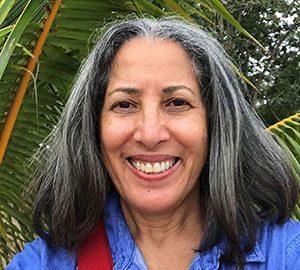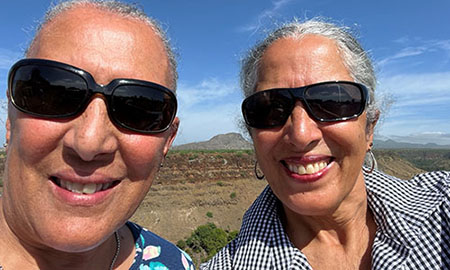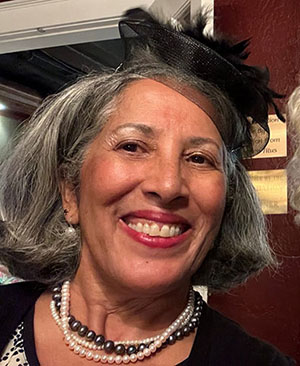Patient StoryJan | 3 | 2025
Lung Cancer Patient Story: Multidisciplinary Expertise Backed by Cutting-edge Treatment


"I always start my story with, 'A funny thing happened on the way to Japan,'" said Flora McCoy-Greene.
The then 67-year-old retiree was exploring a move from Massachusetts to Florida when she got a call from an international school in Japan. One of their teachers had fallen ill. The school's director wanted to know if Flora could fill in for awhile.

Flora had taught overseas before and was thrilled at the chance to do it again. But first, she would need to have a complete physical examination, as the school required.
The ensuing exam included a chest X-ray. Flora's primary care doctor reviewed the scan and concluded she might have lung cancer. She was shocked, as she had no symptoms.
"I call the director of the school 'John the Angel' because had he not offered me the job, I wouldn't have gotten the chest X-ray that saved my life," Flora said.
Lung cancer treatment required
The possibility of having lung cancer hit Flora hard. Her husband, Bobby, died of the disease in 1991. "I had smoked for 15 years before that," she said. "The day he was diagnosed was the day I threw my cigarettes in the trash and stopped smoking."
Following her suspected diagnosis of lung cancer, Flora saw a pulmonologist near her home in Onset, Massachusetts. He referred her to Christopher Morse, MD, a thoracic surgeon at Massachusetts General Hospital, for further evaluation.
After taking a biopsy, Dr. Morse confirmed Flora had non-small cell lung cancer (NSCLC), the most common form of lung cancer.

In fact, she had two cancerous masses in her lungs. On the right side, she had stage 3 NSCLC. On the left side, she had stage 1 NSCLC. Since the cancer was confined to the lung and the lymph nodes within the chest, she was considered to have locally advanced disease.
Dr. Morse referred Flora to Mass General Cancer Center. The first doctor she saw there was thoracic medical oncologist Justin Gainor, MD.
"Having two lung cancer sites is not unusual, but it's hard to deal with both at the same time," Dr. Gainor said. "So we decided to focus first on treating the more aggressive cancer on the right side while still monitoring the cancer on the left side."
Proton therapy for lung cancer part of treatment plan
Flora's cancer care team also included radiation oncologist Henning Willers, MD. He and Dr. Gainor decided on a treatment plan that included six weeks of radiation therapy and chemotherapy followed by one year of immunotherapy.
According to Dr. Gainor, having a multidisciplinary, integrated cancer care team is a hallmark of the patient experience at the Cancer Center.
"In the clinic, I see patients with a thoracic surgeon, a radiation oncologist, and often a dedicated thoracic radiologist who looks at the scans with us. It really is a team effort," Dr. Gainor said. "This way, the patient is hearing opinions from anyone who is relevant to their care. Our goal is to present the patient with their treatment plan by the end of the visit."
When Flora first met with Dr. Willers, she asked about the "latest and greatest" in radiation therapy. Dr. Willers mentioned that she may be eligible for a lung cancer clinical trial in which some patients receive proton beam therapy rather than traditional radiation therapy.
Proton therapy, an advanced form of radiation therapy, delivers a high-energy, focused proton beam to the tumor. It is designed to do less damage to healthy tissue near the tumor than traditional radiation therapy. Mass General has two proton therapy centers; no other hospital in New England even has one.
Flora expressed interest in the trial and was later deemed eligible to participate.
"The therapies available today for lung cancer are completely different than 10, five, three, or even one year ago. Things are moving at lightning speed, and regulatory approvals can lag," Dr. Gainor said. "Sometimes the best way to get the patient access to the newest, most promising therapies is through a clinical trial."
Surviving lung cancer with immunotherapy
Dr. Willers designed a plan for Flora's radiation therapy that would fit the requirements of the trial. She underwent 35 rounds of radiation at Mass General — each about 15 to 20 minutes — over the six-week period. Although the radiation left her extremely tired, she didn't experience any skin discoloration or peeling.
During the same stretch, Flora also had three rounds of chemotherapy at Mass General. Dr. Gainor designed this plan. At each appointment, she was given the medicine via intravenous (IV) infusion for about 90 minutes. She opted to receive acupuncture to prevent nausea and other side effects of chemotherapy.
"I tolerated chemotherapy well because of the regimen my team employed to prevent, minimize, or get ahead of side effects," Flora said. "I followed the plan laid out for me completely."
The next step in Flora's care journey was immunotherapy treatment for lung cancer. Dr. Gainor designed the plan for the immunotherapy, which stimulates the body's immune system to find and attack cancer cells.
Flora received immunotherapy via IV infusion at an oncology center closer to her home. The infusions took place every two to four weeks. Each one took 30 to 60 minutes.
"This was a stage 3 cancer, a serious cancer diagnosis," Dr. Gainor. "Nonetheless, our goal from the start was to get rid of it forever. That meant incorporating new therapies—not just radiation and chemo but also immunotherapy."
Lobectomy marks end of lung cancer treatment
A few days after completing immunotherapy, Flora moved to Palm Bay, Florida. A couple years later, a CT scan picked up a slight change in the mass on the left side of her chest. She flew to Boston to see Dr. Morse, who recommended surgical treatment.

Flora returned to Mass General two months later for the lobectomy under Dr. Morse. This surgery involves removing the lobe (portion) of the lung where the mass resides along with nearby lymph nodes. Two days after the procedure, she headed back home.
"I run out of words to express how empathetic and understanding everyone at Mass General has been," Flora said. "The nurses—I can't sing their praises high enough. And the doctors—I feel like I hit the jackpot with the team of doctors I've had. They've all been superb."
Two-and-a-half years after her surgery, Flora, 72, is cancer-free and enjoying life in warmer climes. She stays active and has become a vocal advocate for lung cancer screening, especially for people with a history of smoking.
"We know lung cancer screening saves lives, but the uptake in the United States is incredibly poor," Dr. Gainor said. "We need to do a better job getting more people screened for lung cancer, and Flora is helping to get the word out."

Her care team at Mass General remains part of Flora's life. She sees Dr. Gainor in person every three to six months. During each trip to Boston, she also sees Dr. Morse via video consultation.
"I continue to go back because I'm sticking with the people who saved my life," Flora said. "I feel very fortunate to have gotten the very best care that's available anywhere in the world."
Originally published on Mass General Brigham on December 12, 2024.
-
![]()
- Program Director, Center for Thoracic Cancers
- Director, Targeted Immunotherapy
- Associate Professor of Medicine at Harvard Medical School
-
![]()
- Co-Director Gastroesophageal Surgery Program
-
![]()
- Director, Thoracic Radiation Oncology Program
- Director, Radiation Biology & Research Program
- Associate Professor, Harvard Medical School
Related Program
Type
Centers and Departments
Topics
Patient Stories
View inspiring cancer survivor stories from Mass General Cancer Center’s community of patients, families, and staff.
Mass General Cancer Center
An integral part of one of the world’s most distinguished academic medical centers, Mass General Cancer Center is among the leading cancer care providers in the United States.



